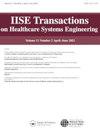考虑到放射科医生的偏见,调查补充乳腺癌筛查试验的有效性
IF 1.5
Q3 HEALTH CARE SCIENCES & SERVICES
IISE Transactions on Healthcare Systems Engineering
Pub Date : 2022-07-05
DOI:10.1080/24725579.2022.2095466
引用次数: 2
摘要
摘要众所周知,乳腺密度会增加乳腺癌症的风险,降低乳腺X线筛查的敏感性。乳腺密度通知法要求医生告知乳腺密度高的女性这些潜在风险。法律通常要求医疗保健提供者通知患者使用更敏感的补充筛查测试(即超声波和MRI)的可能性。自该法律颁布以来,一直存在争议:(i)由于放射科医生在乳房X光图像的乳房密度分类方面的潜在偏见,该法律的实施存在争议;(ii)是否有必要对所有高乳房密度患者进行补充筛查。在这项研究中,我们建立了一个有限范围、离散时间的部分可观察马尔可夫链,以研究补充筛查的有效性以及放射科医生的错误分类偏差对患者结果的影响。考虑到患者一生中患癌症为主要疾病,预期的补充检查次数为次要患者的结果,我们考虑最终在早期状态下检测到乳腺癌症的条件概率。我们的研究结果表明,仅根据患者的乳房密度将其转诊至补充检查可能不一定能改善其健康结果,在进行此类转诊时需要考虑其他风险因素。此外,普通熟练放射科医生的表现与完美放射科医生相当(即,乳腺密度分类的准确率为100%)。然而,乳房密度分类的显著偏差(即,乳房密度等级的持续升级或降级)可能会对患者的健康结果产生负面影响。本文章由计算机程序翻译,如有差异,请以英文原文为准。
Investigating the effectiveness of supplemental breast cancer screening tests considering radiologists’ bias
Abstract Breast density is known to increase breast cancer risk and decrease mammography screening sensitivity. Breast density notification laws require physicians to inform women with high breast density of these potential risks. The laws usually require healthcare providers to notify patients of the possibility of using more sensitive supplemental screening tests (i.e., ultrasound and MRI). Since the enactment of the laws, there have been controversial debates over (i) their implementations due to the potential radiologists’ bias in breast density classification of mammogram images and (ii) the necessity of supplemental screenings for all patients with high breast density. In this study, we formulate a finite-horizon, discrete-time partially observable Markov chain to investigate the effectiveness of supplemental screening and the impact of radiologists’ misclassification bias on patients’ outcomes. We consider the conditional probability of eventually detecting breast cancer in early states given that the patient develops breast cancer in her lifetime as the primary and the expected number of supplemental tests as the secondary patient’s outcome. Our results indicate that referring patients to a supplemental test solely based on their breast density may not necessarily improve their health outcomes and other risk factors need to be considered when making such referrals. Additionally, average-skilled radiologists’ performances are shown to be comparable with the performance of a perfect radiologist (i.e., 100% accuracy in breast density classification). However, a significant bias in breast density classification (i.e., consistent upgrading or downgrading of breast density classes) can negatively impact a patient’s health outcomes.
求助全文
通过发布文献求助,成功后即可免费获取论文全文。
去求助
来源期刊

IISE Transactions on Healthcare Systems Engineering
Social Sciences-Safety Research
CiteScore
3.10
自引率
0.00%
发文量
19
期刊介绍:
IISE Transactions on Healthcare Systems Engineering aims to foster the healthcare systems community by publishing high quality papers that have a strong methodological focus and direct applicability to healthcare systems. Published quarterly, the journal supports research that explores: · Healthcare Operations Management · Medical Decision Making · Socio-Technical Systems Analysis related to healthcare · Quality Engineering · Healthcare Informatics · Healthcare Policy We are looking forward to accepting submissions that document the development and use of industrial and systems engineering tools and techniques including: · Healthcare operations research · Healthcare statistics · Healthcare information systems · Healthcare work measurement · Human factors/ergonomics applied to healthcare systems Research that explores the integration of these tools and techniques with those from other engineering and medical disciplines are also featured. We encourage the submission of clinical notes, or practice notes, to show the impact of contributions that will be published. We also encourage authors to collect an impact statement from their clinical partners to show the impact of research in the clinical practices.
 求助内容:
求助内容: 应助结果提醒方式:
应助结果提醒方式:


